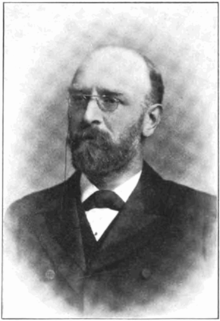Arthur Smith Woodward
Sir Arthur Smith Woodward (born May 23, 1864 in Macclesfield , Cheshire , England, † September 2, 1944 in Haywards Heath , London ) was a British paleontologist .
Live and act
Woodward spent childhood and school in Macclesfield. He then moved to Manchester and studied at Owens College there .
In 1882, at the age of 18, he started working for the British Museum . About ten years later he was Assistant Keeper of Geology . In 1901 he became the manager ("keeper") of the paleontological department of the British Museum; he held this position until 1924. In 1904 he became President of the Geological Society of London . During his tenure at the British Museum, Woodward did research on extinct vertebrates, especially fish. He undertook research trips to South America and Greece, among others .
The discovery of the so-called Piltdown man , which was brought to him by Charles Dawson , on the one hand established Woodward's fame during his lifetime, but on the other hand brought him into disrepute after his death. After the find was brought to him and he had examined the site and the skull bones extensively, he presented the find on December 18, 1912 to a meeting of the Geological Society of London. The Piltdown man was dated to an old age of several 100,000 years and was hyped up to be the "missing link" in human evolutionary history, with which Woodward achieved world fame. It was not until 1953, after Woodward's death, that the find turned out to be a brazen forgery. Although the course of the forgery could not be exactly reconstructed to this day, Woodward is one of the main suspects.
In 1921 he assigned the fossil skull Kabwe 1 from Broken Hill, Northern Rhodesia (today: Kabwe in Zambia ) as a holotype of the new species Homo rhodesiensis . According to the prevailing opinion of experts today, Kabwe 1 belongs to the group of archaic Homo sapiens , which means that the fossil is close to the immediate ancestors of anatomically modern humans ( Homo sapiens ).
Honors
In 1901 he was elected as a " Fellow " to the Royal Society , which in 1917 awarded him the Royal Medal . In 1914 he received the Clarke Medal from the Royal Society of New South Wales . In 1924 he was knighted . He was also a member of the Geological Society of London , which awarded him the Lyell Medal in 1896 and the Wollaston Medal in 1924 . He was also a member of the Linnean Society of London , from which he received the Linnaeus Medal in 1940 . In 1925 he became a member of the Leopoldina , in 1912 a member and in 1926 a corresponding member of the Paleontological Society . From 1925 he was an honorary member of the then Soviet Academy of Sciences. In 1933 he became a corresponding member of the Bavarian Academy of Sciences .
Fonts
- Palaeoichthyological notes. 1. On the so-called Hybodus keuperinus, Murch. and Strickl. 2. On Diplodus Moorei, sp. nov., from the Keuper of Somersetshire. 3. On a symmetrical Hybodont tooth from the Oxford Clay of Peterborough. 4. On a maxilla of Saurichthys from the Rhaetic of Aust Cliff, near Bristol. In: Ann. Mag. Nat. Hist. 3 (6), 1889, pp. 297-302
- A catalog of the fossil fishes in the British Museum (Natural History), Part I, London 1889
- with Charles Davies Sherborn : A catalog of British fossil vertebrata , London 1890
- A catalog of the fossil fishes in the British Museum (Natural History), Part II, London 1891
- A catalog of the fossil fishes in the British Museum (Natural History), Part III, London 1895
Web links
- Entry to Woodward; Sir; Arthur Smith (1864-1944) in the Royal Society Archives , London
swell
- Short biography entry at Minnesota State University, Mankato. Archived from the original on October 27, 2010 ; accessed on January 21, 2014 .
- Entry in Britannica , 15th edition, 1998. (Eng.)
Individual evidence
- ^ Arthur Smith Woodward: A New Cave Man from Rhodesia, South Africa. In: Nature . Volume 108, 1921, pp. 371-372, doi: 10.1038 / 108371a0 .
- ^ Member entry of Sir Arthur Smith Woodward at the German Academy of Natural Scientists Leopoldina , accessed on February 6, 2016.
- ↑ Arthur Smith Woodward's membership entry at the Bavarian Academy of Sciences , accessed on February 6, 2016.
| personal data | |
|---|---|
| SURNAME | Woodward, Arthur Smith |
| BRIEF DESCRIPTION | British paleontologist |
| DATE OF BIRTH | May 23, 1864 |
| PLACE OF BIRTH | Macclesfield , Cheshire , England |
| DATE OF DEATH | September 2, 1944 |
| Place of death | Haywards Heath , London |
